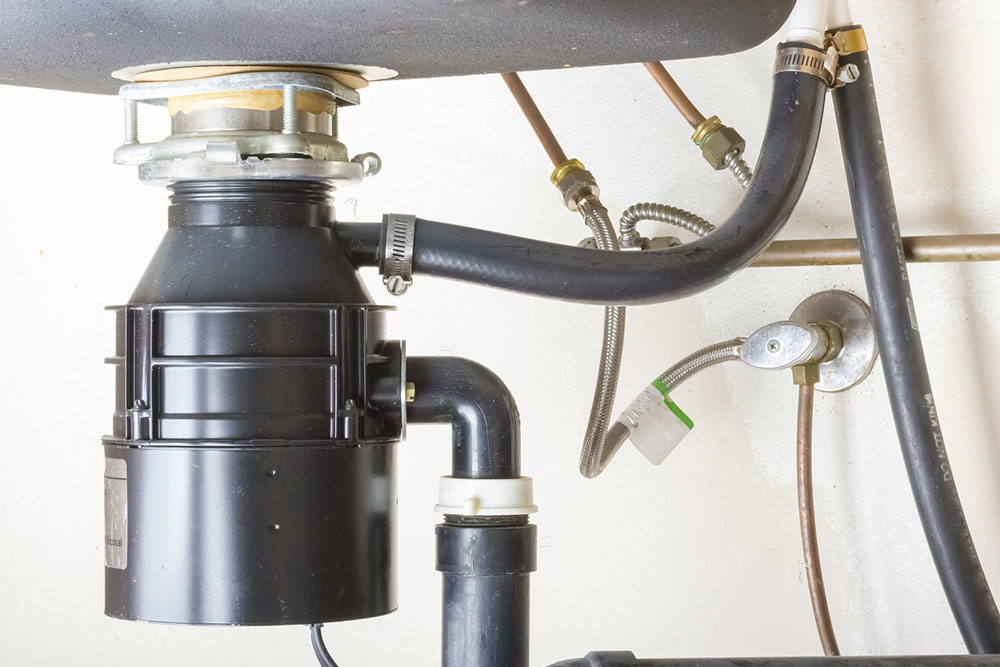A brief guide to garbage disposals

Garbage disposal is a common kitchen device that can help get rid of food scraps without clogging the plumbing. It is usually electrically powered and installed beneath the kitchen sink. It grinds down the food scraps into small particles that can flow through the plumbing without causing blockages. Knowing about what a garbage disposal system can do and its benefits can help one decide if getting one for their kitchen is a good idea.
How does a garbage disposal system work?
A garbage disposal is an electrical appliance installed beneath the kitchen sink. It is connected to the drainpipe of the sink and the house’s plumbing system. When activated, the disposal utilizes a spinning impeller with blunt edges that grinds food waste against the grinding chamber. This includes leftover food, vegetables, fruits, peels, and more. The water from the faucet flushes the ground-up particles down the drain. To ensure the garbage disposal runs smoothly, it should have uninterrupted access to running water, as this helps the waste pass without clogging the drain.
Benefits
Sink garbage disposals can save a lot of time, effort, and materials required for discarding food waste. So, one doesn’t have to run to the garbage often, making kitchen cleanup easier.
– Garbage disposal protects the plumbing, so if food accidentally slips down the kitchen sink drain, it will not clog the drain.
– It is an affordable device. A standard garbage disposal system can cost as little as $70 and can last almost a decade if it is maintained properly. One may end up spending more on plumbing and repairs without garbage disposal if food gets stuck in the pipe.
Drawbacks
– Garbage disposals can require a lot of maintenance. Most need weekly maintenance and cleanup.
– Garbage disposal systems might not be as easy to use as expected. They can jam and clog if not used as per the manufacturer’s instructions. So, it is important to avoid pushing all kinds of waste into the disposal system. For instance, extremely hard food waste, like large fruit pits or seeds, can damage the system.
One should go through the instructions to avoid damaging the system and clogging the drain.
Tips for using garbage disposal
1. Be careful during installation
Although installing a garbage disposal can be a DIY project, it requires following a specific set of steps for a secure and leak-free connection. So, one must first turn off the power and water supply, then disconnect the old unit (if any), prep the new unit, mount and secure the garbage disposal, and then connect the drainpipes and dishwasher hose. All of this requires carefully handling electrical connections. Finally, one may also have to perform certain checks and tests as per the manufacturer’s manual. One should keep an eye out for leaks after installation. The last step is to turn the power back on.
2. Dispose of foods gradually
Going slow is crucial, as feeding the disposal tiny amounts of food waste at a time prevents overloading, which can lead to clogs. One must also run cold water simultaneously, as it helps push the ground-up particles down the drain, preventing them from accumulating and causing clogs within the disposal unit or pipes.
3. Use citrus peels
Citrus peels, like lemon and orange peels, contain natural deodorizing properties. Grinding them once in a while can help neutralize unpleasant odors that can emerge from the disposal unit, especially when dealing with strong-smelling food scraps.
4. Use the disposal often
Even when one does not have food scraps to get rid of, running the disposal for a few seconds with cold water can be beneficial. It helps keep the grinding components sharp and prevents rust buildup. Food scraps naturally contain some moisture, but running the disposal occasionally with just water ensures the blades stay lubricated.
5. Maintain cleanliness
Over time, grease and food particles can build up within the disposal unit, leading to unpleasant odors and clogs. Using a commercial cleaner according to the manufacturer’s instructions is essential for maintaining a clean and functional sink garbage disposal. These cleaners typically come in liquid or gel form and are designed to break down grease buildup and deodorize the disposal unit.
6. Avoid pouring down oil
While it might seem convenient to pour leftover cooking oil or grease down the drain, this could be a mistake. Grease and oil can stick to pipes as they cool, causing blockages that can be difficult and expensive to remove. So, it is best to let cooking grease cool and solidify in a container before discarding it in the trash.
7. Don’t use the disposal for all foods
Stringy vegetables like celery, artichoke chokes, or corn husks can be problematic for garbage disposals. These fibrous foods can wrap around the disposal’s grinding components, causing clogs or damaging the motor. Also, eggshells are surprisingly tough and can dull the blades of the garbage disposal over time. Additionally, the membrane inside eggshells can contribute to clogs. Another food to avoid putting in the garbage disposal is coffee grounds. While seemingly small, the grounds can clump together and form clogs within the disposal unit or further down the drainpipes. So, one should get rid of these items by tossing them in the trash.


